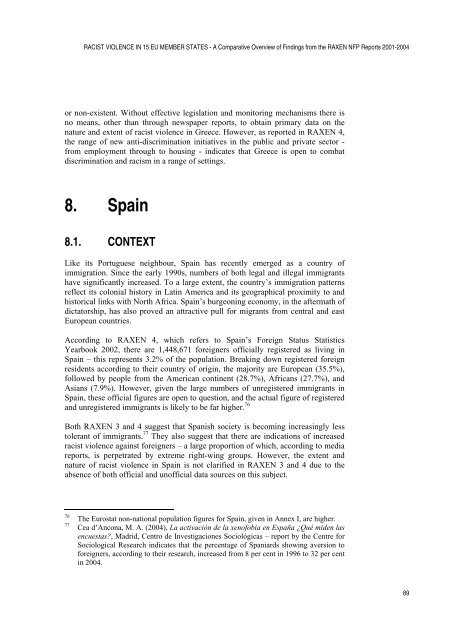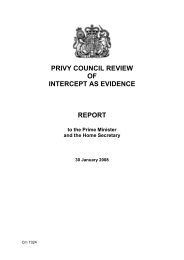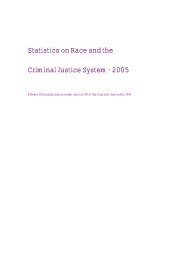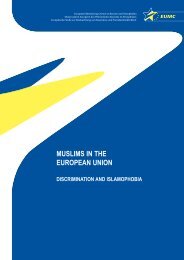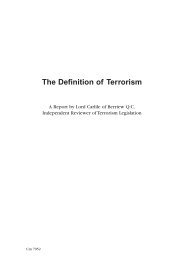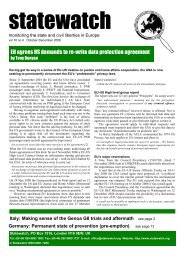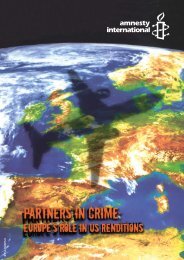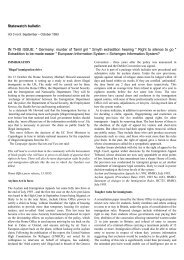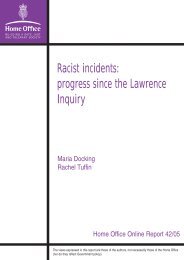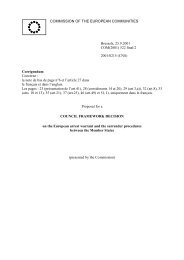RACIST VIOLENCE IN 15 EU MEMBER STATES - Cospe
RACIST VIOLENCE IN 15 EU MEMBER STATES - Cospe
RACIST VIOLENCE IN 15 EU MEMBER STATES - Cospe
Create successful ePaper yourself
Turn your PDF publications into a flip-book with our unique Google optimized e-Paper software.
<strong>RACIST</strong> <strong>VIOLENCE</strong> <strong>IN</strong> <strong>15</strong> <strong>EU</strong> <strong>MEMBER</strong> <strong>STATES</strong> - A Comparative Overview of Findings from the RAXEN NFP Reports 2001-2004<br />
or non-existent. Without effective legislation and monitoring mechanisms there is<br />
no means, other than through newspaper reports, to obtain primary data on the<br />
nature and extent of racist violence in Greece. However, as reported in RAXEN 4,<br />
the range of new anti-discrimination initiatives in the public and private sector -<br />
from employment through to housing - indicates that Greece is open to combat<br />
discrimination and racism in a range of settings.<br />
8. Spain<br />
8.1. CONTEXT<br />
Like its Portuguese neighbour, Spain has recently emerged as a country of<br />
immigration. Since the early 1990s, numbers of both legal and illegal immigrants<br />
have significantly increased. To a large extent, the country’s immigration patterns<br />
reflect its colonial history in Latin America and its geographical proximity to and<br />
historical links with North Africa. Spain’s burgeoning economy, in the aftermath of<br />
dictatorship, has also proved an attractive pull for migrants from central and east<br />
European countries.<br />
According to RAXEN 4, which refers to Spain’s Foreign Status Statistics<br />
Yearbook 2002, there are 1,448,671 foreigners officially registered as living in<br />
Spain – this represents 3.2% of the population. Breaking down registered foreign<br />
residents according to their country of origin, the majority are European (35.5%),<br />
followed by people from the American continent (28.7%), Africans (27.7%), and<br />
Asians (7.9%). However, given the large numbers of unregistered immigrants in<br />
Spain, these official figures are open to question, and the actual figure of registered<br />
and unregistered immigrants is likely to be far higher. 76<br />
Both RAXEN 3 and 4 suggest that Spanish society is becoming increasingly less<br />
tolerant of immigrants. 77 They also suggest that there are indications of increased<br />
racist violence against foreigners – a large proportion of which, according to media<br />
reports, is perpetrated by extreme right-wing groups. However, the extent and<br />
nature of racist violence in Spain is not clarified in RAXEN 3 and 4 due to the<br />
absence of both official and unofficial data sources on this subject.<br />
76<br />
77<br />
The Eurostat non-national population figures for Spain, given in Annex I, are higher.<br />
Cea d’Ancona, M. A. (2004), La activación de la xenofobia en España ¿Qué miden las<br />
encuestas?, Madrid, Centro de Investigaciones Sociológicas – report by the Centre for<br />
Sociological Research indicates that the percentage of Spaniards showing aversion to<br />
foreigners, according to their research, increased from 8 per cent in 1996 to 32 per cent<br />
in 2004.<br />
89


